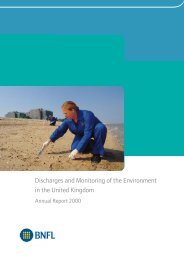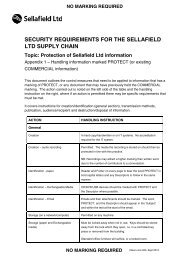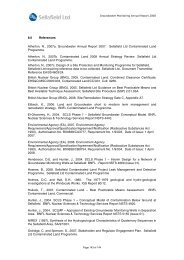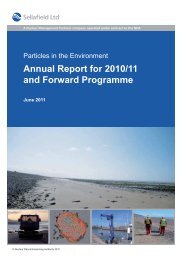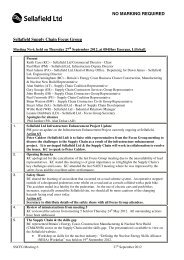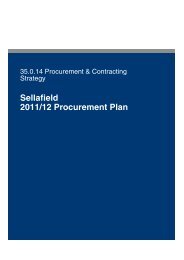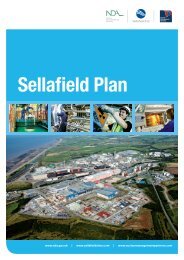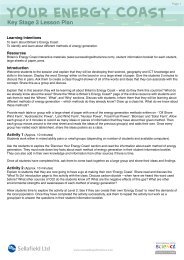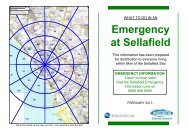Waste management: nuclear waste treatment ... - Sellafield Ltd
Waste management: nuclear waste treatment ... - Sellafield Ltd
Waste management: nuclear waste treatment ... - Sellafield Ltd
- No tags were found...
Create successful ePaper yourself
Turn your PDF publications into a flip-book with our unique Google optimized e-Paper software.
<strong>Waste</strong> <strong>management</strong> overview<strong>Waste</strong> <strong>management</strong>:<strong>nuclear</strong> <strong>waste</strong> <strong>treatment</strong>,storage and disposalwww.nda.gov.uk | www.sellafieldsites.com | www.<strong>nuclear</strong><strong>management</strong>partners.com
We deliver an integrated <strong>nuclear</strong> <strong>waste</strong> <strong>management</strong>programme which seeks to reduce <strong>waste</strong> volumesarising as part of our current activities as well ashistoric operations, ensuring that <strong>waste</strong> is stored safely,minimising the risk to the public and environment.Nuclear <strong>waste</strong> treatmenWe are world leaders in <strong>nuclear</strong> <strong>waste</strong> <strong>management</strong> and havesuccessfully processed and stored low, intermediate and high level<strong>nuclear</strong> <strong>waste</strong> from UK and overseas customers at our sites for over50 years.We have made major advances in the <strong>treatment</strong>of these <strong>waste</strong>s over the past 30 years with thedevelopment and implementation of comprehensive<strong>waste</strong> <strong>management</strong> processes and techniques.These include the development and introduction of<strong>treatment</strong> for high level <strong>waste</strong> and encapsulationtechnology used to treat intermediate level <strong>waste</strong>.Significant progress has already been made with the retrievaland <strong>treatment</strong> of historic as well as current <strong>waste</strong> arisings. Futurechallenges in <strong>waste</strong> <strong>management</strong> lie in supporting the delivery ofhigh hazard reduction at <strong>Sellafield</strong> and Capenhurst and accelerationof this mission.<strong>Sellafield</strong> site.Our employees are worldleaders in <strong>nuclear</strong> <strong>waste</strong><strong>management</strong>.
We have 50 years experience in the <strong>treatment</strong> and storage of <strong>nuclear</strong> <strong>waste</strong>.t, storage and disposal
The greatest technical challenge we face isthe cost-effective retrieval and <strong>treatment</strong>of the historic <strong>waste</strong>s at <strong>Sellafield</strong>.Challenge
Nuclear <strong>waste</strong>categorisation.% High level <strong>waste</strong>1% Intermediate level <strong>waste</strong>1980% Combination of low level<strong>waste</strong>, very low level <strong>waste</strong>and exempt <strong>waste</strong>sSuccessfully managingall types of <strong>nuclear</strong> <strong>waste</strong>Early <strong>waste</strong> <strong>management</strong> activities at <strong>Sellafield</strong>involved the storage of untreated <strong>waste</strong> from thefirst generation reprocessing operations associatedwith the military programme which took place at<strong>Sellafield</strong> during the 1950s. <strong>Waste</strong> arising from theprogramme was historically held in ponds and siloswith no plans for future <strong>treatment</strong> and disposal.Our task today is to retrieve and process thismaterial as well as manage the arisings producedfrom current reprocessing operations.With safety at the forefront of everything we do,our employees face some challenging but excitingtimes ahead. Representing some of the mostsignificant long term activities on the <strong>Sellafield</strong>site, our mission is to safely and efficientlymanage the disposition of <strong>waste</strong> toensure high hazard risk reduction. Wewill continue to develop innovativeand cost effective solutions to enableacceleration to this mission and indoing so, contribute towards a cleanerand safer environment.Tom Foster,NMP Executive Director for <strong>Sellafield</strong> <strong>Ltd</strong>,<strong>Waste</strong> and Effluent DispositionVery low level <strong>waste</strong> (VLLW)VLLW is radioactive <strong>waste</strong> with verylow concentrations of radioactivity.At <strong>Sellafield</strong>, this refers toradioactive <strong>waste</strong> which due to theconcentration levels in relation to itstotal activity can be disposed of tospecified landfill sites.High level <strong>waste</strong> (HLW)The most radioactive form of <strong>nuclear</strong><strong>waste</strong> and is produced when spentfuel has been reprocessed throughthe Magnox and Thorp facilities. At<strong>Sellafield</strong>, we treat this <strong>waste</strong> througha process called vitrification. Thisinvolves converting the high-levelliquid <strong>waste</strong> into a solid form,reducing the volume of the liquid<strong>waste</strong> to one third of its originalsize. Vitrifying the <strong>waste</strong> enables thematerial to be stored safely and inpreparation for eventual transportand permanent long term storage.Intermediate level <strong>waste</strong> (ILW)Comprises of materials such as fuelelement cladding, contaminatedequipment, radioactive sludge andplutonium contaminated materialthat arises from both historic andcurrent operations. At <strong>Sellafield</strong> ILWis put into stainless steel drums,which are then filled with cementgrouting before being placed intoa special above-ground storagefacility on the site.Low level <strong>waste</strong> (LLW)Only slightly radioactive andincludes items such as protectiveclothing, laboratory equipment,paper towels and gloves which havebeen used in the controlled areasof a <strong>nuclear</strong> site, hospital or <strong>nuclear</strong>research centres. LLW is treatedat <strong>Sellafield</strong>’s <strong>Waste</strong> Monitoringand Compaction Plant – where it iscompacted, placed inside an ISOfreightcontainer and transportedfor disposal at the UK’s Low Level<strong>Waste</strong> Repository.Exempt <strong>waste</strong>Exempt <strong>waste</strong> is deemed to becompactable bagged <strong>waste</strong>classified as exempt in accordancewith Radioactive Substances Act 93and is disposed of through an offsite landfill facility.Our purpose built facilitiesallow us to safely manageall types of <strong>nuclear</strong> <strong>waste</strong>.
We are committed to ensuringthat future <strong>waste</strong> generationis minimised and avoidedwherever possible.World class expertise in <strong>nuclear</strong> <strong>waste</strong><strong>management</strong> and minimisation.Capability and expertise<strong>Waste</strong> <strong>management</strong> represents one of our mostsignificant activities and is a major area of expertise.The amount of <strong>waste</strong> generated at <strong>Sellafield</strong> isminute compared with the total industrial anddomestic <strong>waste</strong> produced each year in the UK.However, due to its radioactive content, we takegreat care to manage our <strong>waste</strong> using provenand effective methods of <strong>treatment</strong> and storageto ensure that the public and the environmentare protected. We do this by continually investingin significant resources and expertise to safelymanage all levels of radioactive <strong>waste</strong>.We are committed to theintelligent application ofthe <strong>Waste</strong> ManagementHierarchy in all aspectsof our <strong>waste</strong> activities.For the past 20 years we have been successfully treating andmanaging high level <strong>nuclear</strong> <strong>waste</strong> in our Vitrification Plant wherewe have the capability to convert high level <strong>waste</strong> into a solid,stable form suitable for permanent long term storage.<strong>Sellafield</strong> is the only <strong>nuclear</strong> site in the UK that provides an interimstorage facility for both high and intermediate level <strong>waste</strong>. It is alsothe only designated site in the UK that operates a purpose built lowlevel <strong>waste</strong> compaction facility.The Solvent Treatment Plant, which came into operation in 2000, isthe only facility in the UK which can process radioactive solvents toa safe end point compatible with a long term safe <strong>waste</strong> product.So far, 3,000m 3 of historic solvent stocks has now been processeddown to minimum inventory levels.Every aspect of our <strong>waste</strong> operations is conducted with due careand consideration for the environment.We are committed to ensuring that future <strong>waste</strong> generation isminimised and avoided wherever possible and are doing this bydeveloping our capability in <strong>waste</strong> sorting, segregation and sizereduction techniques. Likewise, ongoing studies into the options forminimising metal and demolition <strong>waste</strong>s through processes such asincineration will also help us ensure that maximum volume reductionis achieved.<strong>Sellafield</strong> is home to the UK’sonly high level <strong>waste</strong> <strong>treatment</strong>and storage facilities.
ExpertsOn the <strong>Sellafield</strong> site we are dealingwith some of the most radioactivematerial known to man.
A number of projects and initiatives are under wayacross <strong>Sellafield</strong> <strong>Ltd</strong> to ensure that innovative solutionsare realised to enable the delivery of our integrated<strong>waste</strong> <strong>management</strong> programme.Current <strong>waste</strong> projectsThe Integrated <strong>Waste</strong> Strategy is akey enabler in accelerated clean-upat the <strong>Sellafield</strong> site which will alsodeliver major benefits by reducing<strong>waste</strong> volumes in the intermediateand low level <strong>waste</strong> categories.Laurence Cook, Head of <strong>Waste</strong>Our third Encapsulated Product Store (EPS3) isnearing completion and will provide additionalcapacity to support the two existing stores at<strong>Sellafield</strong> which house intermediate level <strong>waste</strong>.EPS3 will take intermediate level <strong>waste</strong> arising from bothreprocessing operations and decommissioning work at <strong>Sellafield</strong>,providing interim storage for encapsulated <strong>waste</strong> on the site.Work to construct a sludge packaging plant (SPP1) at <strong>Sellafield</strong> isprogressing towards a completion date of 2014. The 1st buffer storagevessel has been assembled (33m long, 7m wide and 3.5m high) andtransferred into the building – representing the largest stainless steelfabrication on the site since the 1980s. A further two vessels are dueto be completed towards the end of 2012. Once completed, SPP1 willprovide the site with a designated facility for receiving and processinglegacy sludge retrieved from the first generation magnox storage pondprior to long term storage or disposal.Site preparation for the fourth Highly Active (HA) Liquid Evaporator(Evaporator D) began in 2008, with the first concrete pour of thebase slab in mid 2009. The site’s HA evaporators play a pivotal role inthe delivery of reprocessing, historic clean-up and hazard reductionmissions across the <strong>Sellafield</strong> site by concentrating the volume ofthe radioactive liquid <strong>waste</strong> through an evaporative heating process.AchievementsThe first ever high active <strong>waste</strong>shipment from <strong>Sellafield</strong> to overseascustomers commenced in 2010 aspart of the Vitrified Residue ReturnsProgramme.With shipments undertaken from theUK to Japan and the Netherlands, thefirst two consignments were receivedsafely, securely and in full regulatorycompliance by June 2010.In 2011, our Miscellaneous Beta Gamma <strong>Waste</strong>(MBGWS) teams reached an impressive safetymilestone. Responsible for providing safe and securestorage for intermediate level <strong>waste</strong>, the team of30 worked 15 years without a lost time accident.15 yearswithout a lost timeaccident.
Evaporator D will provide<strong>Sellafield</strong> will additionalevaporative capacity.The modules are beingdelivered to <strong>Sellafield</strong> bysea and installed using agantry on site.Evaporator D will provide additional evaporative capacity to supportthe site’s existing evaporators. Construction of the new facility willinvolve off-site fabrication of a series of large scale modules whichwill then be transported to the site by sea and installed into thebuilding’s concrete shell using a gantry system. This is the first timein the history of the <strong>Sellafield</strong> site that such large-scale modularconstruction will be used.A key milestone in reducing legacy <strong>waste</strong>s stored at<strong>Sellafield</strong> will be reached with the return of vitrifiedresidue to overseas customers.In 2010 we started returning vitrified high level <strong>waste</strong> to overseascustomers in both Japan and Europe.The 10 year Vitrified Residue Returns programme, will seeapproximately 1,850 containers of vitrified (solid) <strong>waste</strong> returned tocustomers in fulfilment of contractual obligations.Delivery of this programme demonstrates the role that <strong>Sellafield</strong> <strong>Ltd</strong>is playing in substantially reducing the volume of solid highly active<strong>waste</strong> temporarily stored at <strong>Sellafield</strong>.plant – the Residue Export Facility (REF) which will be used to loadvitrified (solid) highly active <strong>waste</strong> canisters into a flask for export toour customers in fulfilment of contractual obligations. In total, theUK will return approximately 1,850 containers of vitrified <strong>waste</strong> inaccordance with regulatory requirements.In addition to constructing and developing plants to deal withcurrent and future <strong>waste</strong> arisings, our Integrated <strong>Waste</strong> Strategyfor dealing specifically with low level <strong>waste</strong> is aimed at ensuringtechniques are implemented to minimise and where possible,avoid the generation of this category of <strong>waste</strong>.An average of 900 tonnes of metal a year is processed through ourWheelabrator facility which treats metal by mechanically removingthe outer surface. Once cleaned of contamination, the materialwhich includes redundant metal from decommissioning projects,skip handlers, ISO-freight containers and structural steel can berecycled back into the scrap metal market.One of the main benefits of our Integrated <strong>Waste</strong> Strategy is that ithas the potential to reduce the number of ISO-freights of low level<strong>waste</strong> disposed to the Low Level <strong>Waste</strong> Repository by more than30%, which is equivalent to 20,000 ISO-freight containers.In order to do this, we have commissioned a specially designedIn November 2010, our <strong>waste</strong> teamssafely processed almost the sameamount of plutonium contaminatedmaterial into a passive form over atwo year period compared to thatwhich had previously been processedin the previous 11 years.1,400 tonnesOur Metals Recycling Team processed over 1,400Tesof metal during 2011/2012 against a baseline target of950 tonnes and a stretch target of 1,350 tonnes. Thisincludes nearly 400Tes of metal shipped for off site<strong>treatment</strong> via the LLWR Segregated Services contractincluding 54-Multi element bottles. Over and abovethe 1,400Tes over 1,300Tes of clean metal has beendispatched off the site by the Metals Recycling Team.
Displaying uncompromising safety standards and arobust application of environmental <strong>management</strong>, ourvision going forward will be to continue supporting<strong>nuclear</strong> decommissioning and reprocessing programmesand in doing so, deliver value for money for our customer,the Nuclear Decommissioning Authority.Planning for future<strong>waste</strong> <strong>management</strong>.The futureWe have faced many technical and operationalchallenges in the field of <strong>waste</strong> <strong>management</strong> overthe past 50 years and have consistently deliveredworld class solutions and performance.In addition to supporting upstream plants including Magnox andThorp to ensure optimisation of the site reprocessing programmes,our key focus will remain on minimising the radioactive hazard ofmaterials held and produced at the <strong>Sellafield</strong> and Capenhurst sites.We will support the post operational clean out of <strong>nuclear</strong> <strong>waste</strong> inexisting facilities, as well as the clean-up of those buildings that arecurrently being decommissioned.Safely managing medium active <strong>waste</strong>s, continuing to safely exportvitrified high level <strong>waste</strong> and ensuring that we meet long termstorage requirements are among our key deliverables.Hazard reduction will be realised by using provenand effective methods as well as implementingnew <strong>waste</strong> <strong>treatment</strong> and disposal routes.Protecting the workforce, community and environmentin all our <strong>waste</strong> <strong>management</strong> operations.Reduction of highly active liquor stocks on the site will be achievedthrough safe and effective operation of the <strong>Waste</strong> VitrificationPlant which will enable us to meet regulatory requirements andprogramme end dates.Ongoing trials into the possible <strong>treatment</strong> of intermediate level <strong>waste</strong>from the Magnox Receipt and Storage Decanning Facility in the<strong>Waste</strong> Encapsulation Plant will continue.Following the successful completion of earlier trials involving thetransfer of sludge and solid <strong>waste</strong> to the <strong>Waste</strong> Encapsulation Plantfor encapsulation and safe storage, ongoing work will continue toenable the transfer of larger volumes of intermediate level <strong>waste</strong>to the <strong>Waste</strong> Encapsulation Plant on a more continuous basis inthe future.Likewise, we will also maximise the use of existing liquid effluent<strong>treatment</strong> and intermediate level solid <strong>waste</strong> plants for furtherdecommissioning solutions.We will continue to reduce the environmental impact of ouroperations in accordance with Best Practicable EnvironmentalOption principles. Continued application of our Integrated <strong>Waste</strong>Strategy will ensure that we minimise future low level <strong>waste</strong>arisings and where possible reduce the amount of low level <strong>waste</strong>sentenced to the Low Level <strong>Waste</strong> Repository as well as continuingto recycle <strong>waste</strong> where appropriate to do so.High level <strong>waste</strong> <strong>management</strong>.
ContinualimprovementThrough continual improvementand innovation we will confirmour position as world leadersin <strong>nuclear</strong> <strong>waste</strong> <strong>management</strong>capability and operations.Safety is <strong>Sellafield</strong> <strong>Ltd</strong>’s top priority
www.nda.gov.ukwww.sellafieldsites.comwww.<strong>nuclear</strong><strong>management</strong>partners.com



